Typical geodes

We prefer to recognize or identify minerals by properties we can determine or measure, such as crystal shape, hardness, cleavage, and so on. A locality often does give us a lot of information about what minerals occur at that location, but is not usually something you can observe about a stone. A location where the stone was found does reduce the number of possible options of an unknown mineral from that locality. Sometimes, however, the appearance of a particular mineral or combination of minerals is so typical that we can tell from a piece where it did come from.
Minerals (or manifestations thereof) that are very typical of a particular locality are often also given a local name or a name that also refers to that locality. We see this, for example, with geodes that may be filled with quartz, chalcedony and/or agate. A recent discussion on social media about the use of such local names for various geodes prompted me to write this article about it.
What is a geode anyway?
Geodes are hollow, often round, spaces in rocks filled with minerals. They are usually formed when gas bubbles in volcanic rocks form cavities. Over time, as mineral-rich water seeps into the rock, minerals are deposited in layers on the walls of these cavities. These may be microcrystalline chalcedony, for example, or the banded variety agate, but visible crystals of quartz or other minerals may also form. I think the best known are the amethyst geodes from Brazil, which are often precisely not round but “cathedral”-shaped. Sometimes the cavities are also completely filled and are thus solid when opened. The well-known agate discs are actually slices of such a fully filled cavity.
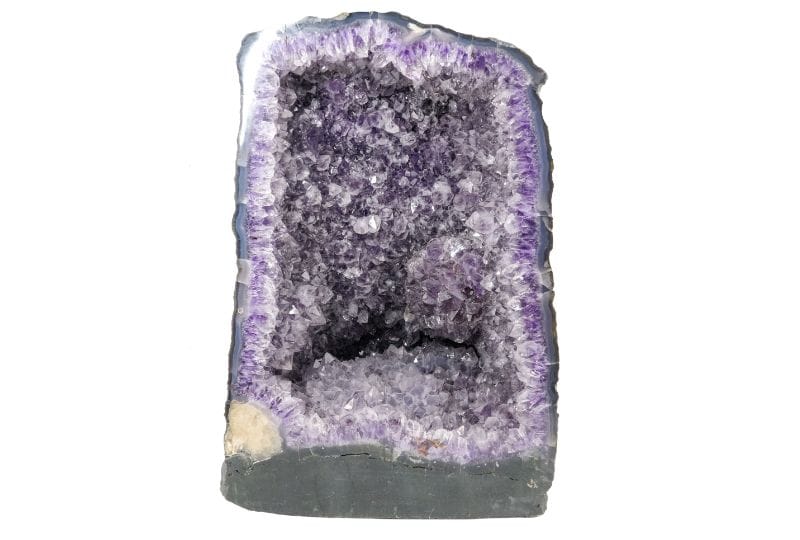
Rio Grande do Sul, Brazil
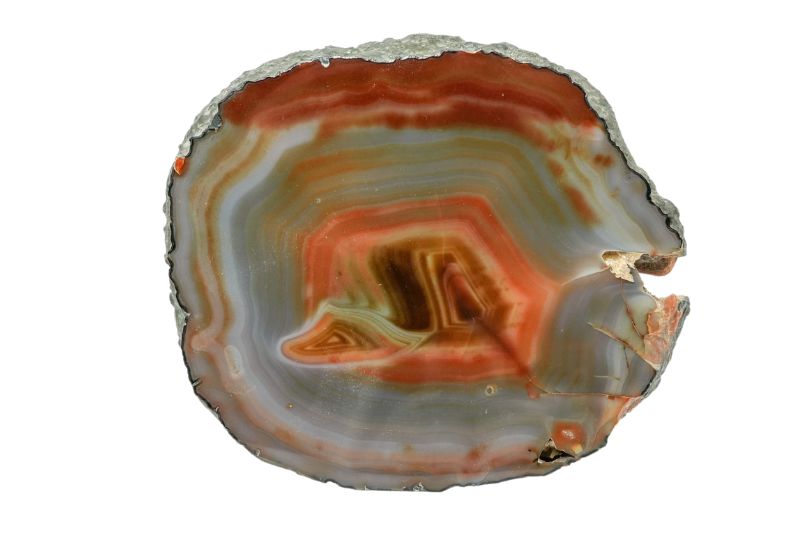
Rio Grande do Sul, Brazil
Some well-known examples
When you start looking for them, there appear to be quite a few different geodes on the market with local names or trade names. I discuss about five of them below.
Puma agate or geode
Geodes with chalcedony, agate and/or quartz found in the Puma Agate Beds in the Mendoza Province in Argentina are called Puma geodes or Puma agates. That area was so named in connection with traces of pumas once found there as well. The agate from this location can show beautiful red and yellow colors, but very typical of all Puma geodes is the green fluorescence under short-wave UV.

Puma Agate Beds, Mendoza province, Argentina
(photo Amor.Rocks)

Puma Agate Beds, Mendoza province, Argentina
(photo SlabMountain via Etsy)

Puma Agate Beds, Mendoza provincier, Argentina (photo Simone Conti via mindat.org)
Red Fox Agate
Also from Argentina, but from Patagonia, comes the so-called Red Fox Agate, also called Crater Agate. Incidentally, the agate is known to locals as Orellanita, after the name of the owner of the ranch where it is found. A rare and beautiful agate variety characterized by its vivid orange-red color, resembling the fur of a red fox. Very typical is the spherical (botryoidal) chalcedony on the inside which owes its red color to inclusions of hematite, an iron mineral. The outer edge usually consists of a dark gray-blue chalcedony, which, like the Puma agate, also fluoresces green under short-wave UV. Red Fox Agate was first found in 1997 in a small deposit about 10 kilometers northwest of the town of Las Plumas in Argentina’s Chubut province. It seems that the deposit is not producing anything new these days; fine specimens are increasingly difficult to obtain.

Las Plumas, Mártires Department, Chubut Province, Argentina (photo GeologyIn)
Las Choyas “coconut” geodes
The geodes of Las Choyas, often called coconut geodes, are perhaps the most famous geodes you can buy to crack on the spot at a fair or in a store. These “spheres” are mined at a depth of 100 to 200 meters at Las Choyas near Aldama Municipality in Chihuahua, Mexico. Shafts are drilled into the white weathered tuffs that contain the geodes and then tunnels are dug to extract the geodes.
The geodes are usually about 5-15 cm in diameter and may contain a variety of minerals and crystals. Most hollow geodes contain a variety of quartz, ranging from clear quartz to smoky quartz and the rarer amethyst. Secondary minerals, such as calcite, goethite and hematite, may also be present in some geodes. Very typical in many of these geodes is the brown edge of siderite.

Las Choyas, Chihuahua, Mexico

Las Choyas, Chihuahua, Mexico
Dugway geodes
These geodes come from what is known as the Dugway Geode Beds in western Utah, United States. About 6 to 8 million years ago, volcanic activity in the area deposited rhyolite (an extrusive magmatic rock), with cavities in which crystals could form. About 32,000 to 14,000 thousand years ago, geodes were eroded from the rhyolite by the wave action of a large lake that covered much of western Utah (Lake Bonneville). These geodes were then deposited in lake sediments. These ancient lake sediments are now known as the Dugway Geode Beds. The most common mineral in these geodes is blue-gray chalcedony with clear quartz, although amethyst may also occur. The geodes are generally relatively small, averaging about the size of a baseball, but there are rare specimens with diameters of one meter. Like the previously described geodes from Argentina, the Dugway geodes also exhibit green fluorescence under short-wave UV, due to uranyl salts in the chalcedony.
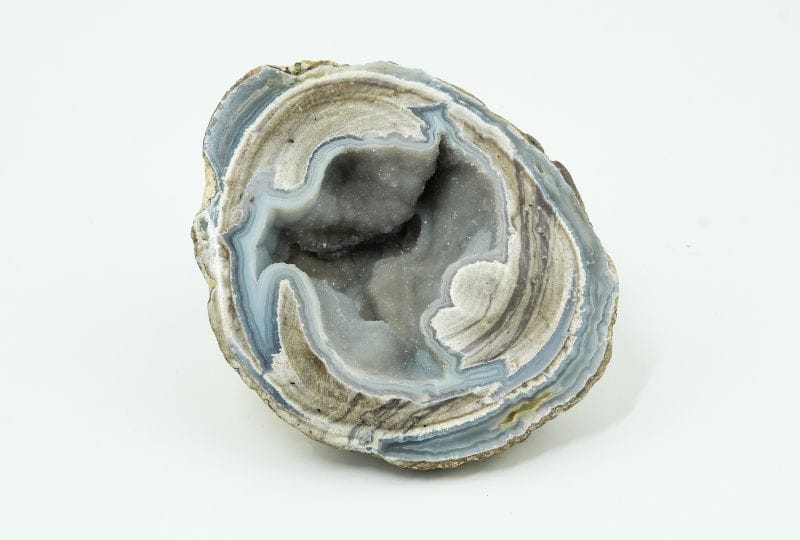
Dugway Geode Beds, Utah, United States

(short wave UV), Dugway Geode Beds, Utah, United States

Dugway Geode Beds, Utah, United States
Ocos or Ochos Occos geodes
As a final example Brazilian geodes that are currently widely available on the market. We see them offered mainly as small “pairs” of two halves and as key chains. These geodes with very typical characteristics come from the Oco geode deposits (Ocho), at Três Pinheiros, Fontoura Xavier, in Rio Grande do Sul, Brazil.
Some sources mention that these geodes are named after the Orinoco River, but that is incorrect. Although the river rises at the border with Brazil, it continues northeast into Venezuela. The site of the geodes is in southern Brazil, in Rio Grande do Sul. It is therefore more likely that the name is derived from the Portuguese word oca or oco for “hollow.”

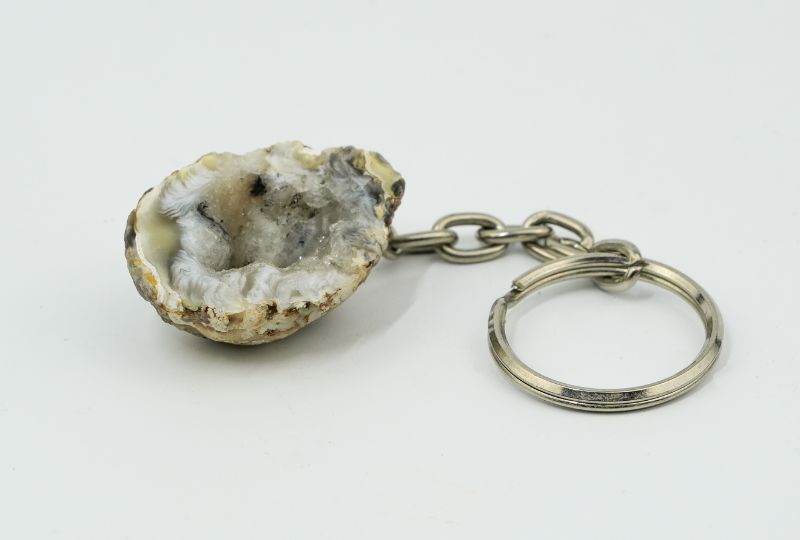
Ocos geodes were formed in basalts some 130 million years ago. Over time, the basalts weathered and the small geodes were left behind in what is now called cascalho, a dark reddish-brown soil in the Serra Geral Formation. Ocos are found mainly when farmers plow the soil in the 900-meter-high regions of the Tres Pinheiros (Three Pines). The Ocos found are then transported in burlap sacks or buckets on horseback or by pack mules to the town of Soledade for sawing and polishing.
These geodes are very easily identified by a relatively thin outer shell of chalcedony that often has a ropey, sinuous appearance. The size of the Ocos is usually small (3-8 cm). Polished, the Ocos exhibit layers of clear quartz or rarely amethyst on gray, brown or black chalcedony with a structure of typical white waves, flames or feathers. The Ocos are therefore sometimes called cloud or feather agates. Many Ocos additionally have inclusions in the quartz, including goethite. The geodes with the very thin exterior, called “casa fina,” are often sold at a higher price, but show less of the famous wavy or flame-like patterns on the rim.

inside clear quartz
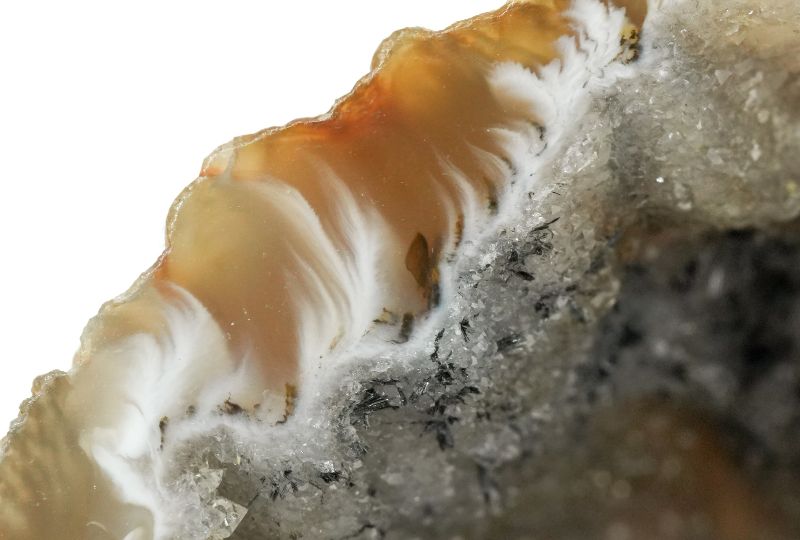

Oco geode deposits (Ocho), at Três Pinheiros, Fontoura Xavier, in Rio Grande do Sul, Brazil
This article previously appeared in my April 2024 Written in Stone newsletter.
Discover the world of minerals and gemstones every month and sign up for my newsletter! Receive updates on new activities, learn fascinating facts, read the latest analysis and enjoy extensive in-depth stories.






Responses